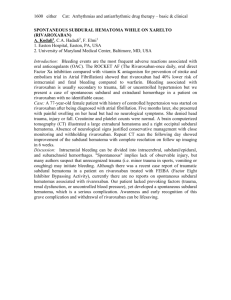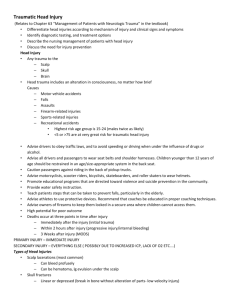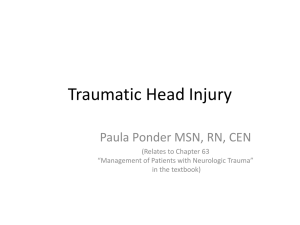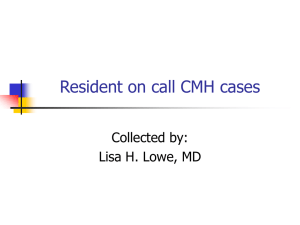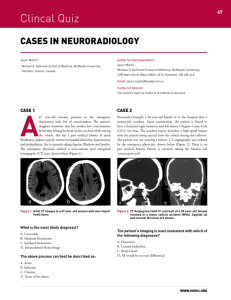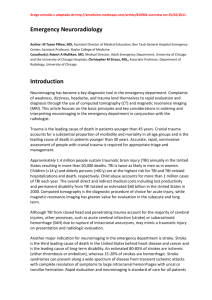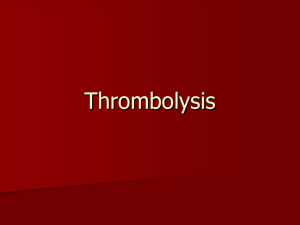PREOPERATIVE DIAGNOSES:
advertisement
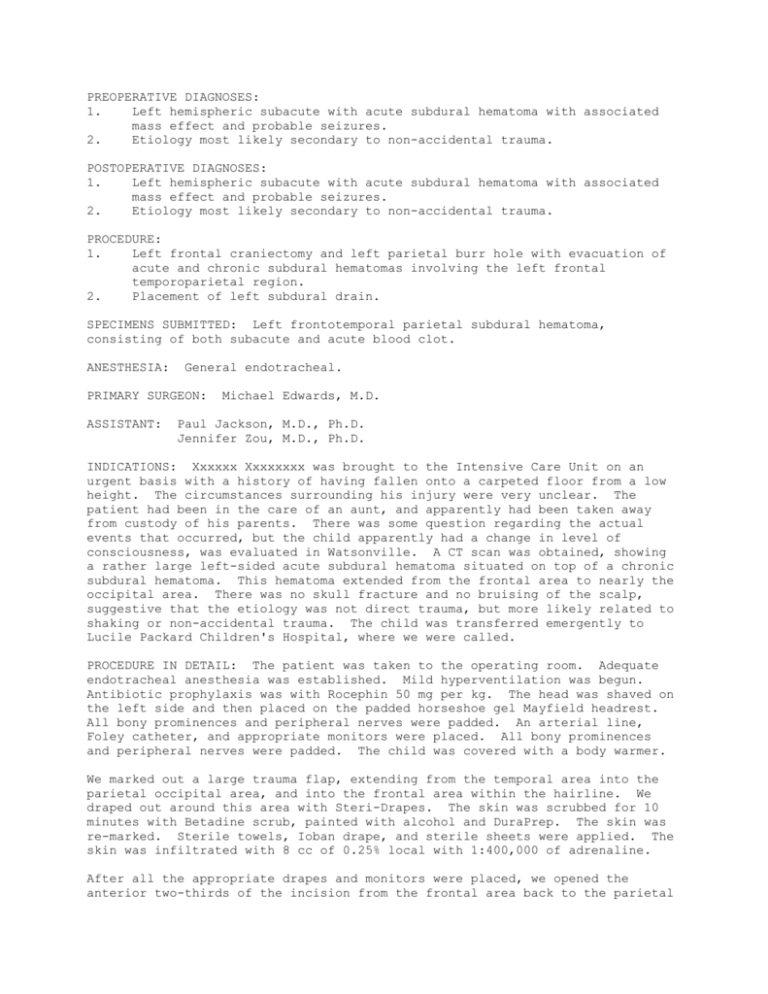
PREOPERATIVE DIAGNOSES: 1. Left hemispheric subacute with acute subdural hematoma with associated mass effect and probable seizures. 2. Etiology most likely secondary to non-accidental trauma. POSTOPERATIVE DIAGNOSES: 1. Left hemispheric subacute with acute subdural hematoma with associated mass effect and probable seizures. 2. Etiology most likely secondary to non-accidental trauma. PROCEDURE: 1. Left frontal craniectomy and left parietal burr hole with evacuation of acute and chronic subdural hematomas involving the left frontal temporoparietal region. 2. Placement of left subdural drain. SPECIMENS SUBMITTED: Left frontotemporal parietal subdural hematoma, consisting of both subacute and acute blood clot. ANESTHESIA: General endotracheal. PRIMARY SURGEON: ASSISTANT: Michael Edwards, M.D. Paul Jackson, M.D., Ph.D. Jennifer Zou, M.D., Ph.D. INDICATIONS: Xxxxxx Xxxxxxxx was brought to the Intensive Care Unit on an urgent basis with a history of having fallen onto a carpeted floor from a low height. The circumstances surrounding his injury were very unclear. The patient had been in the care of an aunt, and apparently had been taken away from custody of his parents. There was some question regarding the actual events that occurred, but the child apparently had a change in level of consciousness, was evaluated in Watsonville. A CT scan was obtained, showing a rather large left-sided acute subdural hematoma situated on top of a chronic subdural hematoma. This hematoma extended from the frontal area to nearly the occipital area. There was no skull fracture and no bruising of the scalp, suggestive that the etiology was not direct trauma, but more likely related to shaking or non-accidental trauma. The child was transferred emergently to Lucile Packard Children's Hospital, where we were called. PROCEDURE IN DETAIL: The patient was taken to the operating room. Adequate endotracheal anesthesia was established. Mild hyperventilation was begun. Antibiotic prophylaxis was with Rocephin 50 mg per kg. The head was shaved on the left side and then placed on the padded horseshoe gel Mayfield headrest. All bony prominences and peripheral nerves were padded. An arterial line, Foley catheter, and appropriate monitors were placed. All bony prominences and peripheral nerves were padded. The child was covered with a body warmer. We marked out a large trauma flap, extending from the temporal area into the parietal occipital area, and into the frontal area within the hairline. We draped out around this area with Steri-Drapes. The skin was scrubbed for 10 minutes with Betadine scrub, painted with alcohol and DuraPrep. The skin was re-marked. Sterile towels, Ioban drape, and sterile sheets were applied. The skin was infiltrated with 8 cc of 0.25% local with 1:400,000 of adrenaline. After all the appropriate drapes and monitors were placed, we opened the anterior two-thirds of the incision from the frontal area back to the parietal area and slightly into the temporal region with a #15 blade and a needlepoint Bovie scalpel. Hemostasis was established with the bipolar cautery. The scalp was elevated with the pericranium off of the skull and the region of the coronal suture. A roll of sponges was placed beneath the skin surface, moist sponges over the galeal surface, and the flap was retracted with scalp hooks. Using the Midas Rex drill and the dissecting burr, a wide craniectomy was performed, both anterior and posterior to the coronal suture. Hemostasis was established with the bipolar cautery and bone wax. A burr hole was placed in the posterior parietal region. The burr was approximately the size of a nickel, the craniotomy the size of a silver dollar. The dura was coagulated and elevated with a sharp hook. It was opened with a #15 blade. Posteriorly, when we opened the dura, dark liquified blood, consistent with subacute subdural hematoma, was evacuated. Fluid was collected for pathology to document that this was a hematoma consistent of fluid of different ages, suggesting the possibility of multiple episodes of trauma. We allowed the fluid pressure to equalize. We then opened the large craniectomy defect in a similar fashion with a #15 blade and coagulated the dura with the bipolar cautery. In this area, further liquified dark blood exited. We began irrigating through the craniectomy and through the burr hole with warm Physiosol. In doing so, we could identify that the brain was pushed at least 1.5 cm away from the inner table. We then took a very soft feeding tube, which we advanced in the subdural space and began irrigating the subdural space to remove blood products. In doing so, it became obvious that there was a solid clot, consistent with acute subdural, as we had expected. By continuously irrigating with the feeding tube, we were able to mobilize this clot and bring it up towards the craniectomy site. In doing so, we were able to take fine tumor forceps, or fine biopsy forceps and grasp the clot and slowly begin advancing the clot from beneath the bone. Using continuous irrigation from behind the clot, we were able to eventually irrigate the solid portion of the clot, up to the level of the craniectomy and remove the rather significant solid clot, without completing a formal frontotemporal parietal craniotomy. This specimen of solid clot was also sent separately to Pathology to document the different ages of the blood. We copiously irrigated with warm Physiosol, probably using almost a liter of irrigation. The blood loss from the operation was less than 25 cc. We expected that the hematoma was somewhere between 50 and 75, with the maximum of 100 cc. After continuous irrigation and the determination that there was no further solid clot, and that the fluid returned was nearly clear, we placed a piece of DuraGen over the craniectomy site. A piece of Gelfoam was placed over the posterior burr hole, but before placing the Gelfoam, a #8 rounded Blake drain was placed in the subdural space and brought out through a separate stab wound in the left parietal occipital region, to be hooked to a non-pressurized drainage bag system. We irrigated the surface of the skull with antibiotic solution. We brought the scalpel back into position, closed the galea with inverted interrupted #4-0 Vicryl, the skin with running #5-0 Monocryl. A drain stitch of nylon was placed to prevent migration of the drain, and the drain was attached to a bile bag to allow for gravity drainage, rather than suction drainage. The drapes were removed. Xeroform gauze, Telfa, and Tegaderm dressings were applied. The child was awoken, extubated, and transported back to the Intensive Care Unit in guarded condition. The child was anemic on arrival in the operating room, and blood products were started. It was unclear whether the anemia was long-standing and old, or related to the acute event of trauma. In either event, the low hematocrit was corrected. At the end of the procedure, and on arrival in the Intensive Care Unit, the child was noted to be moving all extremities without difficulty. The needle, sponge, and Cottonoid count was correct.

